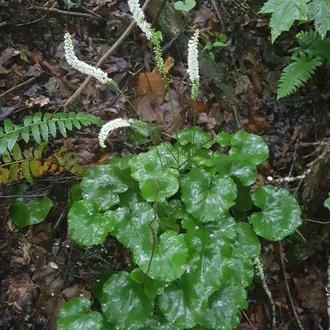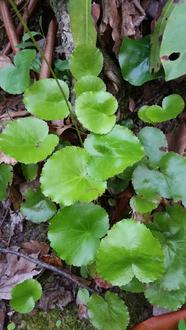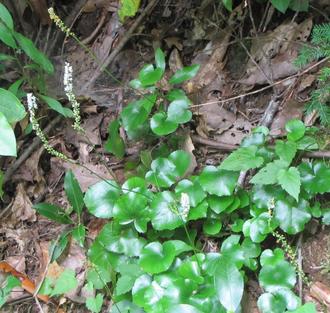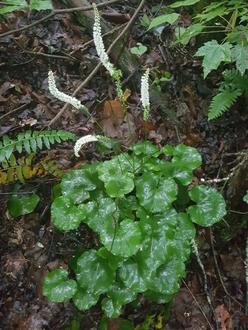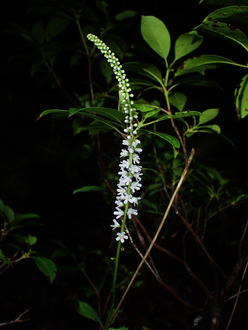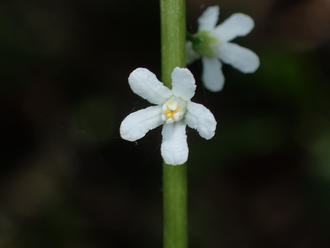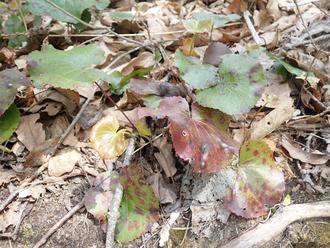Beetleweed (Galax urceolata (Poir.) Brummitt)
Also known as wandplant, wandflower, Galax.
↑Summary
An evergreen perennial mostly limited to the southern Appalachians.
↑Range - Expand
| Legend | Color |
| Introduced | |
| Native or Not Present | |
| Native | |
| Introduced or Not Present | |
| Native or Expanded |
This map is based on our research. We have checked its accuracy to Level 3 ecoregions. Although this plant occurs somewhere in each of these regions, it may only occur in a small part of some or all of them.
This species has been cultivated in gardens far from its native range, and can escape into the wild. We mark the northeasternmost populations as introduced because they are separated from the native range by long distances, but we mark one introduction closer to the native range as expanded. However both of these are subjective judgement calls.
↑Habitat
Found on shady sites in woodlands, in well-drained, acidic soils rich in organic matter, including some rocky soils. Although most populations are in mountains, it can also be found on the coastal plain. Usually grows better on moist sites but also found in dry, wooded sites.
Found in all successional stages of forests; it often is the dominant herbaceous plant in the understory in disturbed and second-growth forests during the early stages of succession, but it persists into later stages in smaller numbers.
↑Life Cycle
Little is known about germination requirements, seedling establishment and survival, seed banking, or lifespan in this species.
This species is, however, capable of reproducing both vegetatively (by rhizomes) and by seed. Individual leaves are typically retained for 18 months.
↑Faunal Associations
Galax is a preferred browse for white-tailed deer and wild turkey, especially during fall and winter when other foliage is scarce. These species rely on galax as a food source most during years when acorns are scarce.
↑Uses
This plant is frequently gathered from the wild for flower arrangements, particularly its foliage, which tends to stay green a long time after being picked; such harvesting has threatened wild populations.
It is occasionally cultivated in gardens, which has led this plant to become established in the wild at several locations quite far north of its native range.
↑Related Plants
This species is the only member of its genus; the broader Diapensiaceae family, however, contains a few related plants, including pincushion plant (Diapensia lapponica), flowering pixiemoss (Pyxidanthera barbulata) and the rarer littleleaf pixiemoss (Pyxidanthera brevifolia), as well as oconee bells (Shortia galacifolia). All of these plants are native to North America; there are some non-native plants in this family as well but none have become established here.
↑Links & External Resources
• Beetleweed | Fire Effects Information System (FEIS) (About This Site)
• Galax urceolata (Beetleweed) | USDA PLANTS Database (About This Site)
• Galax urceolata | Go Botany (About This Site)
• Galax | iNaturalist (About This Site)
• Galax urceolata | Biota of North America Project (BONAP) (About This Site)
• Galax urceolata | NatureServe Explorer (About This Site)
• Galax urceolata | Flora of North America (About This Site)
• Beetleweed | Maryland Biodiversity Project (About This Site)
• Galax urceolata (Poir.) Brummitt (Galax) | Digital Atlas of the Virginia Flora (About This Site)



